|
An Antique That Lasts a Lifetime
by Bob Brooke
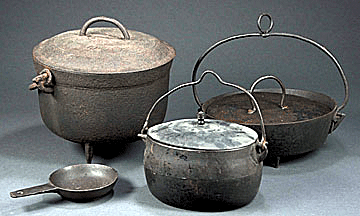 While
other antiques may last as long or longer as a cast-iron skillet, few
can be used regularly and still retain their value. While
other antiques may last as long or longer as a cast-iron skillet, few
can be used regularly and still retain their value.
Cast-iron skillets have been around since 1642. The first one made, a
small, three-legged covered pot that held one quart came from a foundry
in Saugus, Massachusetts. It weighed 2 1/4 pounds, so the lady of the
house probably developed some pretty hefty biceps. The cook on the Lewis
and Clark Expedition not only cooked with cast-iron pots but brought
them along as gifts to the Indians. Back then, cast-iron cookware had
great value, so people took care of it and guarded it as a prized
possession.
While weight was certainly a disadvantage, weight was also associated
with some of cast-iron cookware’s most important advantages. When a
heavy cast-iron skillet reached a cooking temperature, its mass retained
and spread heat evenly over the entire cooking surface. There were no
"hot spots" to cast iron and, when a cook added a metal lid, food could
be kept warm for the duration of the meal.
However, cookware made of cast iron was brittle, prone to rust, grainy,
unfinished and difficult, if not impossible, to repair if cracked. It
was also "reactive." Acidic foods, such as vinegar, tomatoes, and
citrus, re-acted with the iron and changed the flavor and color of
whatever the cook was preparing. The solution seemed to be to season the
it. A non-stick surface wasn’t natural to cast iron. It had to be
created by seasoning or curing the piece. A cook would repeatedly coat a
pot’s inside surface with animal fat and place the utensil in a 250- to
300-degree oven for two to three hours. After wiping away any excess
fat, he or she would lightly rinse it with hot water, using no soap,
then thoroughly dry and store it in a dry place. Many people never ever
put a used piece under water.
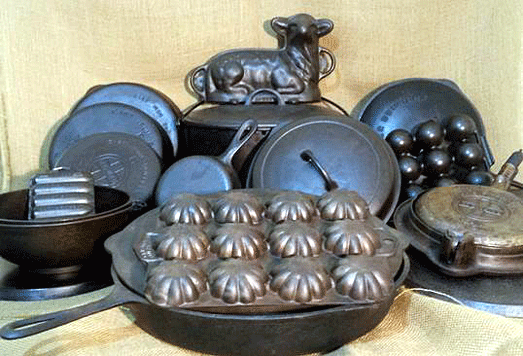
By the 1840s, open hearth
cooking had been replaced by the cast-iron stove which enclosed the fire
in iron and shielded the cook from an open flame. Cooks placed their
pots directly on solid iron plates—not open grates—that formed the top
of the stove. In later models, foundries cut deep holes into the top and
made the iron plates removable. With this innovation, a pot could be
placed into the hole for a snug fit and was as close as possible to the
flame. Stove manufacturers found it to their advantage to add a line of
cast-iron cookware that perfectly fit the removable iron plates or
“eyes” of their stoves.
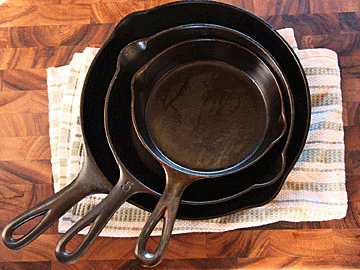 By
the mid-19th-century, foundries that made cast-iron stoves also made
cast-iron cookware— also called hollowware. The Selden brothers, John
and Samuel, operated a foundry in Erie, Pennsylvania, where they
manufactured butt hinges and other household hardware. In 1863, they
added cast-iron cookware to their expanding product line. Because of the
areas widely known foundries, they marked their earliest skillets,
muffin pans, and Dutch ovens with one word, “Erie.” By
the mid-19th-century, foundries that made cast-iron stoves also made
cast-iron cookware— also called hollowware. The Selden brothers, John
and Samuel, operated a foundry in Erie, Pennsylvania, where they
manufactured butt hinges and other household hardware. In 1863, they
added cast-iron cookware to their expanding product line. Because of the
areas widely known foundries, they marked their earliest skillets,
muffin pans, and Dutch ovens with one word, “Erie.”
In 1868, Matthew Griswold joined the Selden brothers. Unlike his
partners, Griswold believed in patenting the products developed in the
foundry. He patented just about everything. The name "Selden and
Griswold" appeared on many cookware items shortly after 1868. At
Samuel's death in 1882, Griswold bought out the remaining family members
and changed the name of the company to his own. He cleverly kept "Erie”
on some of Selden's most popular pieces, but added “Griswold” above it.
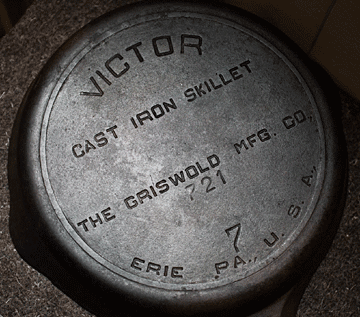 The
Griswold Manufacturing Company and its predecessors produced superior
cookware in an industry dominated by inferior, low-quality goods. In the
late 19th century, cast iron was often made by prisoners. The top of the
Griswold line was "extra finish ware"—cooking utensils with a polished
exterior, a milled interior, and top edges so tight that the connection
between the pan and the lid was a waterproof joint that even the
thinnest knife couldn’t penetrate. The
Griswold Manufacturing Company and its predecessors produced superior
cookware in an industry dominated by inferior, low-quality goods. In the
late 19th century, cast iron was often made by prisoners. The top of the
Griswold line was "extra finish ware"—cooking utensils with a polished
exterior, a milled interior, and top edges so tight that the connection
between the pan and the lid was a waterproof joint that even the
thinnest knife couldn’t penetrate.
Women noticed the difference. Unlike the products made by its
competitors, pieces made by Griswold were thin and lightweight. After
centuries of super heavy pots and pans, Griswold overcame cast iron's
weight problem.
Women also noticed the company's distinctive trademark. Griswold
featured a cross, a sign of quality, on most of its products. Over the
firm’s long history from 1850 to 1957, Griswold Manufacturing Company
produced over 180 cast-iron items. Included in the "non-cookware
category" were cast-iron ashtrays, burglar alarms, fire. sets, gas
heaters, sadirons, mailboxes, pokers, display racks, shovels, spittoons,
sun dials and tobacco cutters. They introduced gas stoves in 1891,
kerosene heaters in 1895, and parlor stoves in 1900.
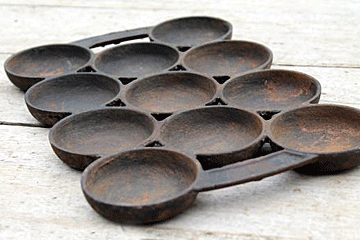 After
the Griswold skillet, the most popular and desirable items for
collectors are the muffin pans. Their variety is astounding with 59
different types of pans for brownies, golf balls, gems, bread and
popovers, among others. And they come in over 200 variations for 2, 6,
8, 11, or 12 square, round or oval muffins in black cast iron, aluminum,
chrome, or enamel. The rarest, selling for $1,800 to $2,500, are the
turk head pan, circa 1925-1930 (#13), the Elie bread pan, circa
1900-1925 (#26) and the wheat and corn stick pan, circa 1925 (#2800). After
the Griswold skillet, the most popular and desirable items for
collectors are the muffin pans. Their variety is astounding with 59
different types of pans for brownies, golf balls, gems, bread and
popovers, among others. And they come in over 200 variations for 2, 6,
8, 11, or 12 square, round or oval muffins in black cast iron, aluminum,
chrome, or enamel. The rarest, selling for $1,800 to $2,500, are the
turk head pan, circa 1925-1930 (#13), the Elie bread pan, circa
1900-1925 (#26) and the wheat and corn stick pan, circa 1925 (#2800).
Although collectors can still find new Griswold items today, through its
current owner, General House Wares Corporation of Sidney, Ohio, the
story ended in 1957. The company just couldn’t compete. The maker of the
world's finest handmade cast-iron cookware found itself up against
cheaper, mass-produced, stamped sheet metal wares. Purists put the final
Griswold date even earlier. The Griswold family ceased their involvement
in the company in 1946 when they sold the business to a group of New
York investors. Subsequent to the sale, the quality of casting dropped
significantly.
Today, the cast-iron skillet dominates most Griswold collections and is
nearly always the first piece a new collector buys.
<
Back to More Antique Spotlights
Next Article > |
